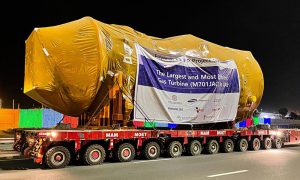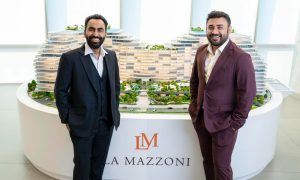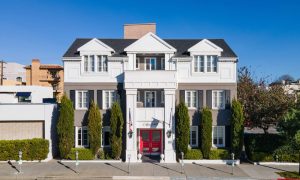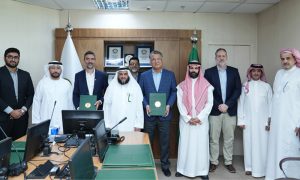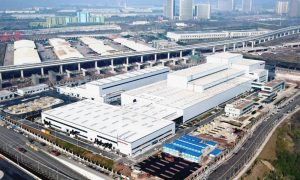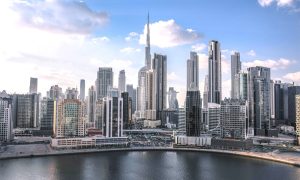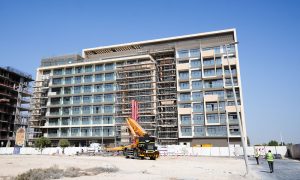Fujairah…. You should be here
“We are placing everything in this project and everything we do will also promote our development”

Following in the footsteps of its famous neighbours, Fujairah is to become the UAE’s next construction capital. With huge commercial, residential and infrastructure ambitions in the pipeline, The Big Project speaks exclusively with the three people who will lead the transformation of this essential Emirate
As famous for its miles of picturesque coastline, as it is for its oil and aggregate production, the Emirate of Fujairah is a mass of contradictions.
Hidden on the far side of the UAE’s only mountain range on the Indian Ocean coast, the weekend getaway destination of choice for expats throughout the UAE, is preparing itself to compete with its world famous neighbours Dubai and Abu Dhabi.
With detailed plans to overhaul everything from the road into the Emirate to the lives of the people living and working there; Fujairah Municipality has bold ambitions.
A number of projects are in the advanced planning stages, with others already tendered and, in collaboration with urban mapping specialists Vectuel, the municipality is pushing ahead with a mega-project that will change Fujairah forever.
Putting a deadline of five years on his dream, general manager of Fujairah Municipality, Mohamed Al Afkham says his vision for the future of the Emirate began years ago.
“Since I was young, I always had this feeling that I wanted to do something for my home town. Many people want to move away from where they grow up to do big projects in places that are already world-famous.
“But I say don’t think about the rest of the world, just concentrate on your home town,” Al Afkham asserts, philosophically elaborating: “Look at what you see, be good in what you do to it, and people will talk about it.”
Having assessed all the elements that contribute to Fujairah’s unique vitality, Al Afkham enlisted French urban software providers Vectuel to create a digital city — the first planning project of its kind in the Middle East.
Two years ago Vectuel regional branch manager Caroline Tasse was enlisted to produce a survey of 50 landmarks in the Emirate including the two most iconic mosques Al Bidya mosque — the oldest in the UAE — and Sheikh Zayed — the second largest in the country.
In addition, the urban plan incorporated a number of historic and cultural sites. Using a software programme called VStory, Vectuel then extended the initial survey to incorporat the wider Fujairah City, creating a sprawling scale model of 10,000 buildings on which to plan the extensive developments now being realised.
Al Afkham says that mapping the project in such a way has not only assisted in the planning stages, but has also promoted the Emirate to potential investors and developers, while also ensuring the feasibility of the plans.
Of the projects deemed workable, perhaps the most vital will be the AED 1.6bn Sheikh Khalifa bin Zayed Road, due to be fully operational by the end of 2011.
Built to solve what the municipality refers to as a “major infrastructure issue”, the road will provide a shorter route between Fujairah and Dubai, Sharjah and Ras Al Khaimah.
Connecting the central region of Fujairah to Dubai via Al Gazirmi locality, Wadi Sahm, Asfeeni, Mamdooh, Kadra and the Shawka valleys in Ras Al Khaimah; the route will end at Maleeha Road in Sharjah. It will slash travelling times between Emirates, not only aiding the convoys of heavy vehicles transporting Fujairah’s aggregate, but further adding to the appeal for weekend visitors and day trippers.
“Most Emiratis want to do something for the country, because the country has been so good to us. Our leaders allow us the opportunity to achieve whatever we want,” Al Akfam says.
“I studied in the US for five years but I chose to come back and use my education to build my country into something great. If you notice from five years ago until now there have been big changes, because we all want to do something
for this country.”
From the ground up
Starting at the very roots of the Emirate’s development, the municipality’s building department is to double in size to provide the required resources to deal with the increased construction activity.
Headed by director of projects Nawal Al Hanaei, the department has confirmed a number of elements linked to the overall plans for Fujairah, some of which are to be financed by a multi-million dirham grant from UAE president Sheikh Khalifa Bin Zayed Al Nahian.
Industrially, these include: an aluminium factory; waste management and sewerage plants; expansion of the national grain storage programme; a 370 kilometre oil pipeline; oil storage; power stations for electricity and water; and development of a sea port set to become so huge it will compete with Rotterdam.
The city will also benefit from the GCC rail project, executed in the UAE by Etihad Rail. Commercial, residential and touristic plans will see the creation of a number of malls and tourism resorts — including eco-tourism projects
in Fujairah and Dibba — and the restructuring of residential housing in the primary industrial area, where more than
30,000 different plots will be divided into neighbourhoods with capacity to accommodate all existing and future residents.
Additionally a new mosque, Sheikh Zayed, has been built in the centre of the town; at 182,885 square metres, it is also the second largest mosque in the country. The number of building permits issued has been rising steadily for months, with the residential and commercial projects comprising the bulk of activity in 2010.
“The most exciting part is that everybody will now know about Fujairah,” says Al Hanaei. Having worked for the municipality for eight years, Al Hanaei holds a Bachelor of Honours in civil management and a Masters in urban planning. Promoted from head of the building department to director of projects this year, she says there is an
atmosphere of anticipation within the department.
“The whole plans are very exciting and will bring more tourists and investors, not only from outside the country but also from within the UAE,” she continues adding that tourism in particular will help to increase the rate of investment in the Emirate.
“When in the past people have only known about Dubai and Abu Dhabi, now they will see what is in Fujairah; and it will also renew excitement in the Middle East if Fujairah becomes a new holiday destination,” she says.
Since welcoming a number of tourists diverted from Egypt during the recent political unrest, Fujairah’s profile has already received a boost this year, albeit an unexpected one. Yet even in 2010 three new hotels opened, bringing the total number in operation to 13, with a combined total of 1684 rooms.
The number of visitors arriving solely through the Emirate’s airport also increased.
Creative ideas
Ironically, the only obstacle to the development plans is also a major source of economic stability; the mountainside.
While the terrain — which accounts for around 80% of the Emirate’s total land — provides the aggregate produced for markets throughout the UAE and sometimes even further afield, it also limits how far the town can physically expand.
That said an ambition which knows no bounds simply works around the dilemma.
Feasibility studies are exploring a huge renewable energy project, which could see photo-voltaic solar panels or even wind turbines built into large areas of the steep terrain, with the dual benefit of powering the Emirate and also freeing up more of the oil refined there for sale.
Al Hanaei also reports planners in the department are looking to other mountainous regions, around the world, to learn how to build into the slopes and maximise the land, ahead of an influx of new businesses, residents and visitors.
“We need creative ideas to use the mountains as accommodation for the people in the new and existing industries and internationally we are looking to other countries to see how they build into mountains,” she says With such strong focus on population and economy, Fujairah cannot afford a land shortage.
It also cannot afford to over-develop the landscape, which in itself plays a pivotal role in so many of the plans; if the authorities are to promote both Fujairah’s industrial and natural attributes, a balance will have to be struck to preserve the environment.
“We can still develop the industrial capacity while preserving the natural beauty and will always protect the landscape and preserve the environment for the coming generations,” Al Afkham says, naming sites such as the Heritage
Village, fort and Hail Palace, as well as the reservoir, coral reefs and wildlife.
Fujairah’s heritage has even drawn the attention of UNESCO, which has protected some of the historic sites and also established an office for its International Theatre Institute (ITI) in the Emirate.
In addition to preserving existing ecosystems, a number of the new developments will be constructed to meet sustainability criteria.
The first such community, comprising 35 bungalows, was recently completed in a suburb called Mudhab. The AED 6 million project was part of comprehensive municipality plans to provide high quality housing and social security; the houses use no timber products and feature highgrade heat insulation to reduce energy consumption.
“We have a lot of work to do, but we have to also balance it and preserve the environment,” Al Akfam adds.
Industrial revolution
In stark contrast, the establishment via Emiri Decree, of the Fujairah Oil Zone (FOZ) in April this year, renewed interest in a robust local economy based on oil refinement.
Run by a new entity, Fujairah Zone for Petroleum Industry will be responsible for all petroleum products, hydro-carbon industries and oil and gas, while also providing infrastructure and buildings for investors at the site. The free
zone facility will be operational from 2012.
The sector will receive a further boost this year when the Habshan–Fujairah oil pipeline is commissioned; reportedly in Q4.
Other major industries booming in the Emirate include quarrying, mining, manufacturing and of course, construction.
Already producing power for the Emirates and processing Abu Dhabi’s oil in its huge plants and refineries, Al Afkham says there are “many other new ideas in the pipeline”, including an extension of the existing national grain reserve project, which could become commercial, and expansions at the already enormous Port of Fujairah; one of the three largest bunkering points in the world.
“We have a lot of other ideas that use Fujairah as an oil hub or sea port. The sea port is expanding rapidly and with this pace of development in a few years it will over-take Rotterdam,” he says.
Both Fujairah’s shipping and petroleum industries will continue to be strengthened according to speakers at the bunkering and fuel oil forum, FUJCON, held in March of this year.
The biannual forum was attended by more than 250 representatives from related industries, who heard the Emirate’s minister for environment and water, Dr. Mohammed Saeed Al Kindi, speak about the importance of PPP contracts during Fujairah’s current period of development.
Currently restricted to no more than 49% ownership of any business in the Emirate, foreign companies are now flocking to the local free zones, based on models similar to Dubai’s Jebel Ali, to establish operations ahead of the increased industrial activity.
Grand plans
Not since Dubai’s gold rush days have such huge ambitions been unveiled in the UAE.
More than mere tenders or contracts, Fujairah’s plans aim to transform everything from the life of its residents to the perceptions of the Emirate and wider Middle East on the world.
“I’m not trying to promote Fujairah simply as a destination but I also want to promote its people,” says Al Afkham.
“Around the world, a lot of people have been misled about Arabic culture and I want to take advantage of this opportunity to open people’s minds and change their perception of the Middle East,” he adds.
The digital mapping produced by Vectuel is the first step in the promotional strategy and has already been taken as far
afield as Germany, to showcase the Emirate’s potential to investors in addition to the organisations already enjoying a
presence there such as UNESCO.
Unlike Vectuel’s other projects in the region — which include complete mapping of Abu Dhabi’s Masdar City — the
Fujairah project is the first to map an existing city and incorporate such close collaboration with a municipality.
“The reason this project is different is because we are working with the government on a strategic level. It’s a territory
management project,” says Tasse.
The government has ideas and they know what they want, so these can be tested here,” she adds.
“More and more we are moving towards digital cities in planning. For example Doha is developing a 3D model, but the
plan for Fujairah is different because it is being used as a promotional tool on many levels,” she continues.
On June 16, Al Afkham took H.H. Sheikh Hamad bin Mohammed Al Sharqi, supreme council member and ruler of Fujairah, on a guided tour of the sites already and soon to be developed.
“Sheikh Mohammed has a vision. When he sees something like this; the place, the plans and the software, he sees the value of it and the fact it is working. You can make 10 mistakes on a piece of paper but this software shows you the ideas and what will work on a scale not seen before.”
“The plan is not only for promotion but also for further planning to help us see if our ideas are suitable for the architects and designers. This is a long term project,” Al Hanaei elaborates.
With the scope of projects underway and multi-million dirham investment funds, the five year project deadline set by Al Afkham may be achievable, but it is unlikely to be the end of his vision.
“We are placing everything in this project and everything we do will also promote our development,” he concludes.
Fujairah: The projects
The Hilal City
The first project of its type in Fujairah, Hilal City will feature 130 towers, in line with residential, commercial and tourism development.
The city will also have a huge commercial centre comprising a five-star hotel, luxury hotel apartments, a commercial shopping centre and hyper markets. A total of 40% of the area will be open and green spaces.
A network of paved roads will also be landscaped, and a number of easy-access roads and bridges will also be constructed.
Sheikh Zayed Mosque
Funded with money from Sheikh Khalifa Bin Zayed Al Nahian’s AED 190 million grant, the Ministry of Public Works designed the mosque — the second largest in the country.
The two-storey mosque will be built in the centre of the city, in an area of 182, 885 square metres, featuring an outer yard surrounded by four colonnades and topped by 35 smalldomes; six 107 metre high minarets, clad in white marble will rise from each corner of the courtyard.
The Fanar Towers
Overlooking the Gulf, the Fanar complex is set in landscaped gardens, and one residential and two 30-storey commercial towers. The project also includes a retail centre with restaurants, cinemas and leisure facilities. The Al Fajer Port (Harbor ) In addition to the industrially focussed expansion of Fujairah Sea Port, the Al Fajer Port will be developed as a leisure destination with boat mooring facilities and promenades.
Fujairah Mall
Located on the road leading into the Emirate, this 100,000 square metre project comprises a commercial centre, hotel, shops, restaurants, cinema, health club and swimming pool. Work on the project began last summer and is due for completion towards the end of December 2012.
The Golden Sand Beach
Inclusive of a 250 room hotel, luxury villas available for rent, a commercial centre with retail outlets and an aqua
leisure resort , a number of international hotel brands are due to be constructed along the coast, including Grand
Hyatt and Intercontinental.











